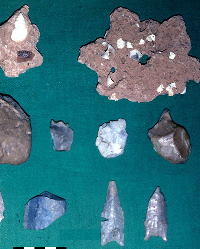
Sub-Stratum 8C shown in 35 foot wall, looking north. The wall profile has been exposed to the weather, and green fungus is growing on the sterile red sand of Stratum 8 above and below, but not the red clay of Sub-Stratum 8C. Photo by Albert Redder.  |

Bifacial adze, or gouge, shown as it was found at edge of Sub-Stratum 8C. The arrow marker lies across the contact between Sub-Stratum 8C at the back of the shelter and the midden pit, which was dug down into this stratum by later Archaic peoples. Photo by Albert Redder. |
|
Sub-Stratum 8C: “Plainview 1”
Separated from the underlying Sub-Stratum 8B by up to 12 inches of red sand, Sub-Stratum 8C is roughly 4 inches thick. A large portion of the deposit, however, was either washed out by floodwaters or destroyed by later, Archaic-period occupants who dug a pit into this stratum from a higher level in the shelter.
Sub-Stratum 8C comprises two layers of red clay, each about 2 inches thick. These are separated by 2 inches of red sand containing a quantity of small angular limestone roof spalls that give it a slightly gravelly appearance. From this level came one lanceolate point (originally classified as Plainview), broken into three fragments, with a small wedge-shaped piece missing. The second point resembles variants of the Dalton type point.
Other tools include bifaces, scrapers, bifacial perforators, gravers, utilized flakes, a bifacial gouge or adze, and a hammerstone of Potter chert. One of the perforators (see photo, right) was recycled from what appears to be a Dalton-like projectile point, judging from its base. The elongated tip is cylindrical The narrow bifacial tool is made of coarse quartzite and resembles both the Clear Fork and Dalton adze varieties. A comparison of Clear Fork tools from the Wilson-Leonard site and Dalton adzes from the Sloan site in Arkansas show striking similarity in metric attributes. Use-wear analysis on Clear Fork tools suggests they were used for diverse tasks, including wood-working and scraping.
A variety of animal bone, including that of birds, small mammals, snake, frog, and turtle, was recovered. Fragments of eggshell, found cemented in the matrix, had curvature and thickness similar to a chicken egg.
Above Sub-Stratum 8C is a deposit of red river sand about 6 inches thick. |

Artifacts from Sub-Stratum 8C including cemented matrix with snail shells, egg shell fragments, chipped-stone tools with graver tips, and two lanceolate projectile points, one of which (bottom right) resembles Dalton variants. Enlarge to see additional materials. Photo by Albert Redder.  |

Specialized tools from Sub-Stratum 8C, including two bifacial perforators (left and right), one of which appears to have been made from a recycled projectile point. At center is a small bifacial tool with beveled bit, variously described as a Clear Fork tool or Dalton adze. Photo by Susan Dial.  |

Chert debitage and animal bone, including bird, small mammal, snake, frog, and turtle. Enlarge to see full image and identifications. Photo by Albert Redder.  |
|




